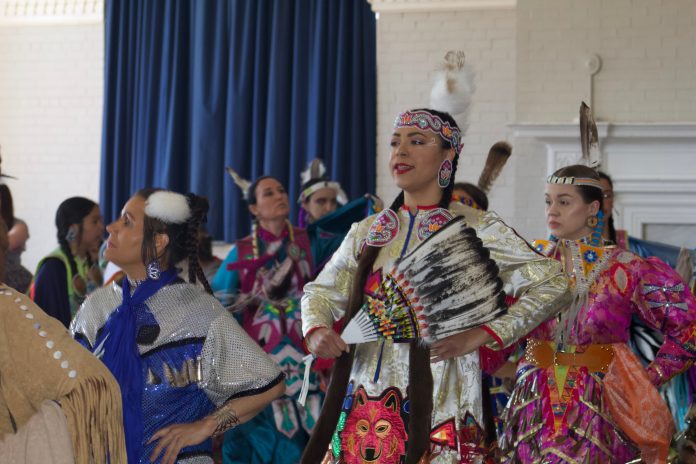The American Indian Student Association Powwow kicked off Sunday with the grand opening ceremony featuring a drum performance and entry made by the event’s traditional dancers clad in vibrant outfits and jingling maracas. The powwow featured an opening prayer, flag song, traditional dances and a veterans’ honor dance. Before the grand entry was made, vendors lined Trinkle Hall to sell handmade American Indian paraphernalia including beads, jewelry and traditional clothing.
Among the many vendors was Alice Elk Moon Call, a beadmaker and owner of Farm Animal Rescue in Gloucester, Virginia. In the last month, Call has attended and sold her work at a reptile show in West Virginia as well as a state-wide archery demo.
“I was a traditional dancer for many years and between physical issues that have kept me from dancing anymore, and the fact that I am now doing fundraising every week has drawn me away from the powwow circuit,” Call said. “This [powwow] is fairly close to me and is easy for me to get here, so this is my fourth year here at this powwow and I must say, I really enjoy it.”
Call is Chickahominy and has been a major part of the powwow circuit since 1987, having been first introduced by her grandparents.
“In my grandparents’ generation, it wasn’t cool to be American Indian,” Call said. “They faced a lot of prejudice and that is why I think it is so important for me to be in touch with my culture. … Once the drums get going, my heart just gets going right with it.”
The grand entry left many in awe, especially beadmaker Tamsye Stover, who was in attendance to the powwow for the fifth year in a row. Stover claims that the ‘addictive’ nature of the drum beat is what keeps her so heavily involved in the powwow circuit.
“I am happy to help support the Native American student alliance here at William and Mary,” Stover said. “This is our first [powwow] of the year, and unfortunately we won’t do another again until May.”
According to Stover, the William and Mary powwow differs from most due to impressive student attendance. For AISA President Margarita Orozco ’21, student attendance was her biggest concern for this year’s powwow. Last year, the powwow fell on the same day as St. Patrick’s Day and thus featured a meager student turnout.
This year, the powwow boasted a much greater crowd. A large percentage of the nearly one thousand students who had expressed interest in the event on Facebook were in attendance.
“Today I hoped for a higher attendance from the student body than in previous years,” Orozco said. “I also hoped that everyone has a good time and enjoys the dances and vendors.”
Orozco joined the club her freshman year. Intimidated at first, she says that she quickly fell in love and feels as if the club offers a family-like atmosphere she blended into naturally.
“This is my second year in the club, and last year as a freshman I was kind of scared of coming, but everyone was so nice, so I was like ‘I’m staying here,’ and it worked out very well,” Orozco said.
Behind the scenic dances, sparkling outfits and inspiring drum beat is weeks of hard work. AISA hosts many smaller events throughout the year, but the powwow is the highlight.
“Our biggest event is the powwow so a lot of organizing goes into it,” Orozco said. “Between hiring the vendors, selecting the dancers and working on social media communications, we all have to play our part.”
Due to the small membership, the members of ASIA work hard to communicate their outreach with others.
“It’s a pretty small club, we do small events for the most part, so the responsibilities as president is reaching out to other groups and letting other people know what we do and about Native American culture,” Orozco said.
A few out-of-town students also were in attendance, including Haley Butcher from Henrico, Virginia.
“I came with my friend who had told me about the event,” Butcher said. “I had never been to a powwow before so the experience was really new but also super neat. I am not American Indian but I’ve certainly gained a much greater appreciation for the culture today. I especially enjoyed the women’s fancy performance, it was inspiring and beautiful.”
Several other students commented on the women’s dance, collectively agreeing on its inspiring nature due to the power and beauty of the women.
“I have never seen so many women dancing as beautifully as they did,” Butcher said. “It was harmonious and flawless. I really hope I am able to make it to next year’s powwow.”


[…] Click here to view original web page at flathatnews.com […]